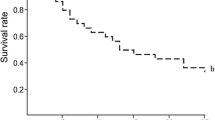Abstract
Some biological potentialities of Pullus mediterranem F. (Coleoptera, Coccinellidae) were studied under controlled conditions. Eggs were laid under carapaces of Saissetia oleae (bdHomoptera, Coccidae), which is an important pest of olive trees. The eclosion of eggs occurred after more than 36 days at 7‡C, but no more than 1, 7 days at 30‡C. The eclosion rate of eggs exceeded 80% between 20 and 30‡C. In homogeneous juvenile population fed with aphids, 4 instars were distinguished on the basis of the width of the cephalic capsule. Mortality rate was low at all temperature tested. It did not exceed 25% at 20‡C and decreased considerably at 30‡C when P. mediterraneus fed on aphids.
Similar content being viewed by others
References
Argyriou, L. Katsoyannos, P. -1976. Installation et dispersion deMetaphycus, parasite deSais- setia oleae à Corfu. -Ann. Inst. Phytopath Benaki,11, 215–224.
Blumberg, D. &Swirski, E. - 1977. Mass breeding of two species of Saissetia for propagation of their parasitoids. -Entomophaga,22, 147–150.
Chemseddine, M. -1988. Les arthropodes frondicoles de l’olivier du Haouz (Maroc). Evolution spatio-temporelle des peuplements et bioécologie des espèces dominantes. Thèse de doctorat d’Etat. Univ. Cadi Ayyad, Fac. Sci., Marrakech, Maroc.
Katsoyannos, P. -1976. Etude d’un prédateur:Exochomus quadripustulatus L. (Coléoptère, Coccinellidae) en vue d’une éventuelle utilisation contreSaissetia oleae OLIVIER (Homoptère, Coccidae), dans les oliveraies de la Grèce. Thèse de docteur-ingénieur, Université des Sciences et Techniques du Languedoc, France.
Panis, A. - 1974. Modalité de dispersion deMetaphycus helvolus. Lâchers en un point d’un verger d’agrumes.Bulletin SROP.,3, 131–134.
Panis, A. -1977. Caractères écologiques et biocénotiques de la cochenille noire de l’olivier:S. oleae. Bolletin del servicio de defensa contra plagas. -Inspeccion Fitopatologica,3, 199–205.
Panis, A. - 1978. Lutte intégrée en verger d’olivier. -L’Olivier,18, 12–14.
Paraskakis, M., Neuenschwander, P. & Michalakis, S. - 1980.Saissetia oleae and its parasites on olive trees in Crete, Greece.Z angew. Entomol, 450–464.
Smirnoff, W. A. - 1956. Observations sur les prédateurs et parasites des cochenilles nusibles du Maroc et sur leurs ennemis. -Serv. Déf. Vég. Maroc. Trav. orig.,11, 60.
Viggiani, G. &Mazzone, P. - 1981. Recent introductions of parasitesofSaissetia oleae in Italy.Fruits,36, 184–185.
Author information
Authors and Affiliations
Rights and permissions
About this article
Cite this article
M’Hamed, T.B., Chemseddine, M. Laboratory Study Of Some Biological Potentialities Of Pullus Mediterraneus (Col., Coccinelidae). Entomophaga 41, 59–62 (1996). https://doi.org/10.1007/BF02893293
Received:
Accepted:
Issue Date:
DOI: https://doi.org/10.1007/BF02893293




